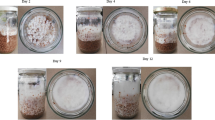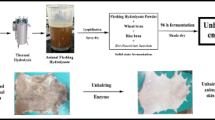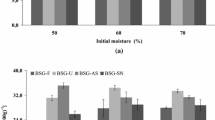Summary
Studies on ensiling of spent solids from solid state fermentation process for production of cellulases byTrichoderma harzianum showed that good quality ensiled solids can be obtained by using about 43% initial substrate dry matter with 0.3% ensiling additive.
Similar content being viewed by others
References
A.O.A.C. (1980).Official Methods of Analysis, 13th ed. Washington DC: Assotiation of Official Analytical Chemists.
Barnett, A.J.G. (1951).Biochem. J.,49, 527–539.
Budiatman, S. and Lonsane, B.K. (1987).Biotechnol. Lett. 9, 597–600.
Gonzalez-Blanco, P., Saucedo-Castaneda, G. and Vinegra-Gonzalez, G. 1990.J. Ferment. Bioeng. 70, 351–354
Jouany, J.P. (1982).Sciences des Aliments,2, 131–144.
Kamra, D.N., Rameshwar, S., and Dass, R.S. (1987).Biological Wastes 20, 111–115.
Kung Jr. L., Grieve, D.B., Thomas, J.W. and Huber, J.T. (1984).J. Dairy Science,67, 299–306.
Lonsane, B.K. (1991). General introduction to economic exploitation.In:Solid Substrate Cultivation (Doelle, H.W., Mitchell, D.A. and Rolz, C.E. Eds) Elsevier Science Publishers, Essex, in press.
Lonsane, B.K. and Ahmed, S.Y. (1989) Some neglected aspects of waste management: Reduction, recycle, utilization and exchange.In Souv. National Symp. on Impacts of Pollution in and from Food Industries and its Management, pp. 33–39, Mysore: Assotiation of food Scientists and Technologists (India).
Lonsane, B.K. and Krishnaiah, M.M. (1991). Leaching of the product and further downstream processing.In:Solid Substrate Cultivation (Doelle, H.W., Mitchell, D.A. and Rolz, C.E. Eds), Elsevier Science Publishers, Essex, in press.
Lonsane, B.K. and Ramesh, M.V. (1990).Adv. Appl. Microbiol. 35, 1–56.
McDonald, P. (1981).The biochemistry of silage, Chichester: John Wiley & Sons.
O'Leary, J. and Hemken, R.W. (1982).J. Dairy Science 65 (Suppl.I), 142–143.
Roussos, S. (1987).Thèse d'Etat, Université de Provence, France, ORSTOM Eds No857-3, Paris.
Roussos, S., Aquiahuatl, M-A., Brizuela, M-A., Olmos A., Rodriguez, W. and Viniegra-Gonzalez, G. (1989).Micol. Neotrop. Apl. 2, 3–17.
Roussos, S., Olmos, A., Raimbault, M., Saucedo-Castaneda, G. and Lonsane, B.K. (1991).Biotechnol. Techniques, in press.
Saucedo-Castaneda, G., Raimbault, M., and Viniegra-Gonzalez, G. (1990).J. Sci. Food Agric. 53, 559–562.
Seale, D.R. (1986).J. Appl. Bacteriol. Symp. Suppl. 61, 9–26.
Seale, D.R., Quinn, C.M., Whittaker, P.A. and Wilson, R.K. (1982).Irish J. Agric. Res. 21, 147–158.
Steinkraus, K.H. (1984).Acta Biotechnol. 4, 83–88.
Toyama, N. (1976).Biotechnol. Bioeng. Symp. 6, 207–219.
Virtanen, A.I. (1952). Microbiologie de l'ensilage.In: Comptes rendus des Journées d'Etudes sur la Conservation des Fourrages, pp. 119–132, Paris, France: Association Française de Zootechnie.
Woolford, M.K. (1984).The silage fermentation, New York: Marcel Dekker.
Author information
Authors and Affiliations
Rights and permissions
About this article
Cite this article
Roussos, S., Raimbault, M., Geoffroy, F. et al. Potential of ensiling for efficient management of spent residue from solid state fermentation system. Biotechnol Tech 6, 87–90 (1992). https://doi.org/10.1007/BF02438696
Received:
Issue Date:
DOI: https://doi.org/10.1007/BF02438696




